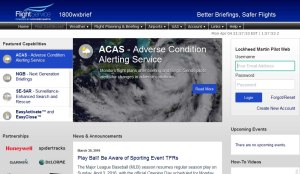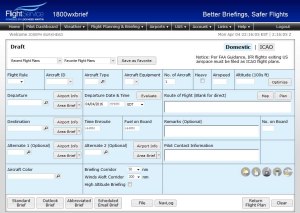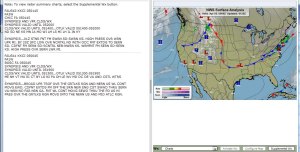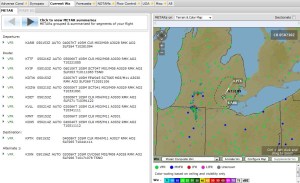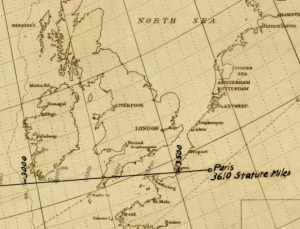I recently discovered that by-and-large the pilot community in my area is fairly unaware of the new computer-based official weather briefing service available at Lockheed Martin’s www.1800wxbrief.com. I discovered it about a year ago myself after using DUATS for many years and became very impressed with its capabilities; so impressed that I’ve been using 1800wxbrief.com ever since! Like DUATS it is tied into Flight Service (FSS) and counts as an official weather briefing (yet I always recommend pilots actually speak with FSS on the phone too), but there are several additional features and capabilities that can make your flight planning, flight filing, situational awareness, and safety of flight even better! I will share my favorite features of this new service. But first I should explain how to get started.
To use the www.1800wxbrief.com site, you will need to create a login ID and password. After you log in you can get an official briefing. Go to the “Flight Planning and Briefing” drop-down menu and select “Briefings, Flight Plans & Nav Logs”.
Next step is to enter all the data in the flight plan form (you don’t have to file the flight plan, but they need the data to provide the briefing), and then choose what type of briefing you want (Standard, Outlook, etc).
Now that you know how to get the briefing, let me tell you why I think this is a great service:
Great visuals
Previous attempts at computer and mobile device official weather briefings had little to no visual depiction of the various products, advisories, TFRs, etc that come up in the briefing. 1800wxbrief.com’s briefings, however, include crisp displays and Next Generation Briefing (NGB) graphics. Here are just a few examples (click on each image to see the great detail offered in these NGB graphics):
Synopsis
Current Weather
NOTAMs
Easy-to-use graphical user interface
Navigating through the menus and briefing is a cinch. Once the briefing is displayed, its just a matter of clicking on the tabs with yellow dots that you want to review. And once you have reviewed a tab the yellow dot goes away so you can keep track of everything you’ve already reviewed and what you still need to review.
Easy filing of flight plans
You can save flight plans for your common flights
If you fly locally, or frequently fly to the same destinations, saving your flight plans for a local flight or a common destination makes the next briefing lightning-fast.
Very fast process
You can just bring up a saved flight plan and all your data is populated from when you saved it, and the only thing you need to do is enter the departure time and modify anything else that might be different for your flight. It only takes me about 10 seconds to get my briefing for a commonly repeated flight after I’ve logged into the website! When I want to talk to a FSS briefer, I usually can have my own briefing on this website brought up and partially or even fully reviewed by the time a briefer is available to talk with me.
Easy filtering and elimination of irrelevant info
Under the NOTAMs section you get a lot of useful information for your flight, often more than what a briefer will tell you about on the phone. But you also get a lot of useless information as well. That said, 1800wxbrief.com lets you filter your NOTAM information so there is less irrelevant information to sift through. For example, if your aircraft doesn’t have an ADF and you aren’t military using TACAN, you can filter both NDB and TACAN NOTAMs out of your search. Not flying ILS approaches today? You can filter those too!
You can activate and close flight plans right from your mobile device
Here’s something really cool. You can set up your mobile device to link up with 1800wxbrief.com so that when you file a flight plan on the site you will get a link sent to your mobile device to activate your flight plan. Then after your flight plan is activated it will send a link for you to close your flight plan-an automatic reminder to close it. Pretty cool!
Submit a PIREP right from your cockpit
Some aircraft, if properly configured, will permit submission of electronic PIREPs directly from cockpit interface without any need to contact Flight Service via radio!
Great tools if you ever need a rescue
There are even some features that enable flight tracking linked to your mobile device! Its called Surveillance Enhanced Search & Rescue (SE-SAR) and it makes use of satellite communications data and ADS-B Out data to determine your location and drastically narrow the search area in the event that you need a rescue.
Although some of the mobile device applications like ForeFlight include graphics and flight plan tools, the 1800wxbrief.com seems to be more complete and visually helpful, at least for now. Next Generation Briefing (NGB)-style views are gradually being integrated into flight planning app’s, and I’m sure we will see more of the rescue integration with FSS in those app’s in the future. But for now I’m really impressed with Lockheed Martin’s 1800wxbrief.com NGB-style products most of all. It makes for a fast, painless, and visually helpful tool for planning flights and being official. Of course it is only part of the flight planning process, and I always recommend pilots speak verbally with a briefer over the phone in addition to reviewing the computer data when going on cross-country flights or when there are questions about the weather, TFRs, etc. Having two sets of eyeballs and brains reviewing the info instead of just one is a great single pilot resource management (SRM) tactic that has helped me discover relevant information for my flight that I wouldn’t have otherwise noticed had I not spoken with a briefer. That said, 1800wxbrief.com has been a great boost to my own situational awareness before flights and since its easier to use I use it more often and if that’s what happens with other pilots then that is a good thing for the pilot community at large.
For more information on how to use Lockheed Martin’s Flight Service, see the LMFS User Guide.

